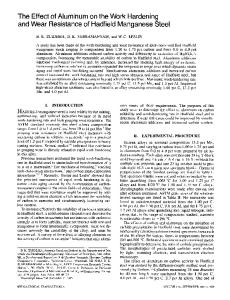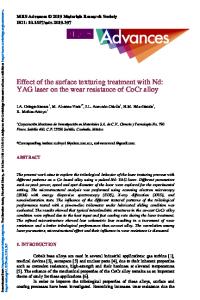Effect of Annealing Temperature on Surface Gradient Fine Microstructure and Wear Resistance of Low-Carbon Steel
- PDF / 2,856,196 Bytes
- 8 Pages / 593.972 x 792 pts Page_size
- 55 Downloads / 371 Views
JMEPEG https://doi.org/10.1007/s11665-020-05129-6
Effect of Annealing Temperature on Surface Gradient Fine Microstructure and Wear Resistance of Low-Carbon Steel Xiangyang Mao, Jianyu Sun, Xiaomeng Zhou, Wenwei Sun, and Xiuming Zhao (Submitted January 4, 2020; in revised form July 14, 2020) The present research investigated the effect of annealing temperature on surface gradient fine microstructure and wear resistance of low-carbon steel. The results depicted that the optimized annealing temperature from 300 °C to 400 °C can facilitate the formation of a stable fine microstructure. The fine grain size is about 0.2 lm on the topmost surface layer, and the percentage of grain boundary with misorientation angle of 1.5° is 26 %. The full width at half maximum values gradually decreases with increasing temperature from room temperature to 600 °C. In addition, the abrasive wear dominates the entire process for samples annealed at 300-400 °C. The wear mechanism gradually switches to adhesive wear and even delamination wear when the annealing temperature is increased to 500-600 °C. Keywords
annealing temperature, gradient fine microstructure, low-carbon steel, wear resistance, wear mechanism
1. Introduction Recently, more and more interest has been drawn in the development of surface gradient structure materials due to the surface severe plastic deformation (SSPD) (Ref 1, 2). The gradient microstructure can be applied to improve performance and prevent the sudden change in properties caused by sudden changes in the microstructure, which has a variety of action mechanisms corresponding to the characteristic size of each microstructure (Ref 3, 4). A few common methods to induce SSPD include surface mechanical attrition treatment (SMAT) (Ref 5), surface mechanical grinding treatment (SMGT) (Ref 6) and ultrasonic impact treatment (UIT) (Ref 7). The gradient microstructure fabricated by SSPD can improve the comprehensive properties of some metals and alloys (Ref 8-10). In particular, numerous studies have demonstrated the advantages of metallic materials for enhancing wear resistance (Ref 7, 10, 11). However, the excellent performance of gradient microstructure is based on their own thermal stability. It is well known that the grain boundaries of gradient microstructure processed by SSPD are unstable with a high density of dislocations and other grain boundary defects (Ref 12-15). The unstable defects are easily rearranged under the high temperature, resulting in grain coarsening and finally transform to stable state. Additionally, the thermal force will promote defect annihilation and drive the gradient microstructure toward a stable state with Xiangyang Mao and Xiuming Zhao, School of Materials Science and Engineering, Nanjing Institute of Technology, Nanjing 211167, China; and Jiangsu Key Laboratory of Advanced Structural Materials and Application Technology, Nanjing 211167, China; and Jianyu Sun, Xiaomeng Zhou, and Wenwei Sun, School of Materials Science and Engineering, Nanjing Institute of Technology, Nanjing 211167, China.
Data Loading...











